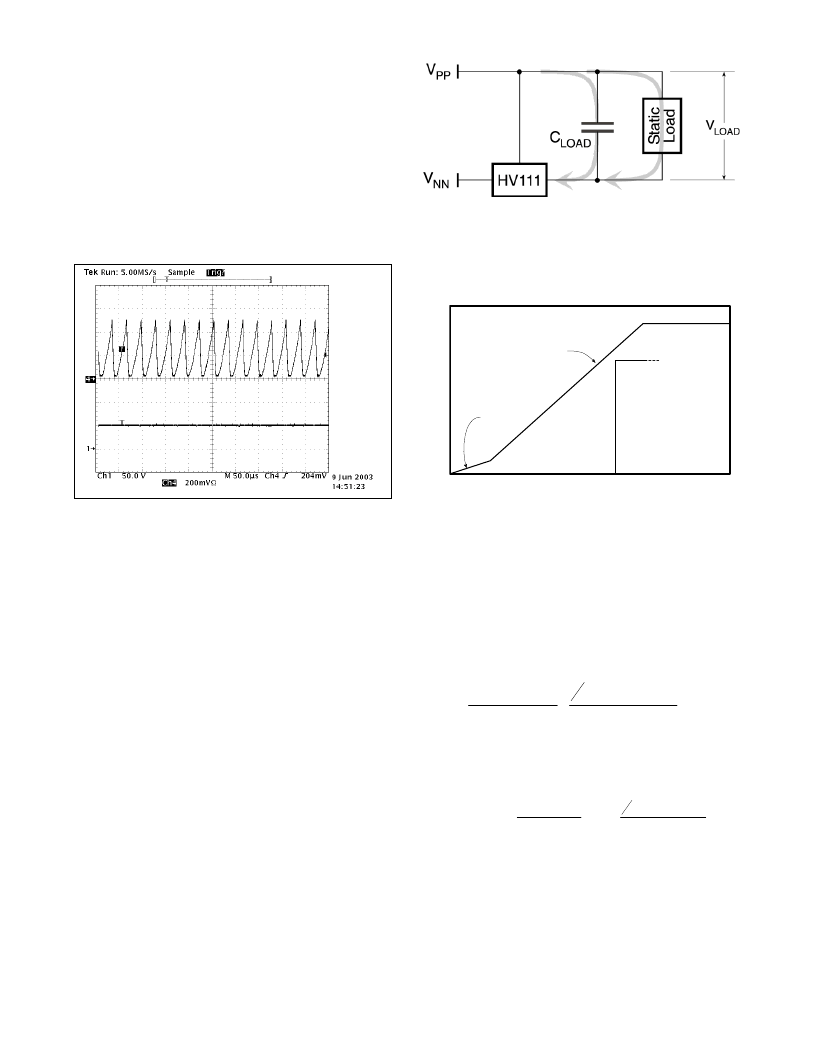- 您現(xiàn)在的位置:買賣IC網(wǎng) > PDF目錄385409 > HV111K4 (SUPERTEX INC) Inrush Limiter/Circuit Breaker/Hotswap Controller IC PDF資料下載
參數(shù)資料

HV111
Fast Clamp
Any MOSFET includes parasitic capacitances Ciss and Cfb.
Until power is available and the HV111 initializes, these
parasitic capacitances form a capacitor divider which will
apply to the gate the ratio of Cfb/(Ciss+Cfb)*V
until the
chip is initialized. To combat this the HV111 includes a fast
acting clamp which will hold off the pass element if it sees
voltage applied on the gate of the internal pass element
even before the HV111 has initialized.
PWM Current Limit (PWM I
limit
)
During power-up, the HV111 provides an inrush limiting
current that supplies both the load capacitor and the static
load. If the static load current is too high, not enough current
will be available to charge the capacitor before the inrush
breaker trips and disconnects the load.
200ma/div
V
PP
-V
NN
I
DS
1V
Inrush Breaker Trip
V
LOAD
0V
40ms
V
Time
1.2A limiting current
230mA
limiting
current
0ms
(V
PP
-V
NN
)
Figure 7 – Shorted PWM I
limit
Figure 8
–
Inrush Breaker Timing
The HV111 includes a unique protection mode not found in
other hotswap controllers. This protection mode is directed
towards severe faults – faults in which the DRAIN voltage is
unable to move more than ~1V from V
PP
.
If such a shorted condition exists then the current will be
limited as shown in Figure 7 above (where the upper
waveform is the ~230mA PWM current and the lower
waveform is the input voltage). Reducing the current under
severe shorts overcomes thermal cycling in which the
HV111 turns on and off as it heats up and cools down in a
severe fault (limiting the current successively to 1.2A until
overheat). It also protects downstream systems by relieving
them of the requirement to handle the 1.2A.
To prevent the inrush breaker from tripping, load voltage
(V
) must exceed (V
-V
) within 40ms. The rate at
which V
ramps up is determined by the current available
to charge the load capacitor (after the static load current is
subtracted from the HV111's inrush limiting current). Inrush
limiting initially is 230mA until load voltage exceeds 1V, at
which point it becomes 1.2A. Thus to prevent the inrush
breaker from tripping, the following equation must be
satisfied. Note that the static load cannot exceed 230mA.
(
)
3
1V
1V
4
40ms
230mA
1.15A
PP
NN
LOAD
STATIC
STATIC
V
V
C
I
I
+
<
Although this protection is extremely helpful in the case of a
severe fault condition, it does put a limit on the charging
current available for static loads.
A special case exists when an always-on (static) load is
present at power-up.
This equation holds as long as the static load is a constant
current. If the static load is a resistance, the equation is a
little more complicated.
(
)
3
1V
1V
4
ln 1
ln 1
40ms
230mA
1.15A
lV
PP
NN
LOAD
R
LOAD
LOAD
R
LOAD
R
V
V
C
+
<
6
相關(guān)PDF資料 |
PDF描述 |
|---|---|
| HV219 | Low Charge Injection 8-Channel High Voltage Analog Switch |
| HV219FG | Low Charge Injection 8-Channel High Voltage Analog Switch |
| HV219PJ | Low Charge Injection 8-Channel High Voltage Analog Switch |
| HV219X | Low Charge Injection 8-Channel High Voltage Analog Switch |
| HV230 | Low Charge Injection 8-Channel High Voltage Analog Switches with Bleed Resistors |
相關(guān)代理商/技術(shù)參數(shù) |
參數(shù)描述 |
|---|---|
| HV113SM-12 | 制造商:SPECTRUM 制造商全稱:Spectrum Microwave, Inc. 功能描述:Voltage Controlled Oscillator |
| HV113T-1 | 制造商:SPECTRUM 制造商全稱:Spectrum Microwave, Inc. 功能描述:Voltage Controlled Oscillator |
| HV116 | 制造商:Apex Tool Group 功能描述:1 IN. X 16 FT HI-VIZ ORANGE SERIES POWER RETURN TAPE |
| HV12 | 制造商:SEMTECH_ELEC 制造商全稱:SEMTECH ELECTRONICS LTD. 功能描述:FAST RECOVERY HIGH VOLTAGE DIODES |
| HV1201B-PVC-BK-N1 | 制造商:HellermannTyton 功能描述:Bulk |
發(fā)布緊急采購,3分鐘左右您將得到回復(fù)。